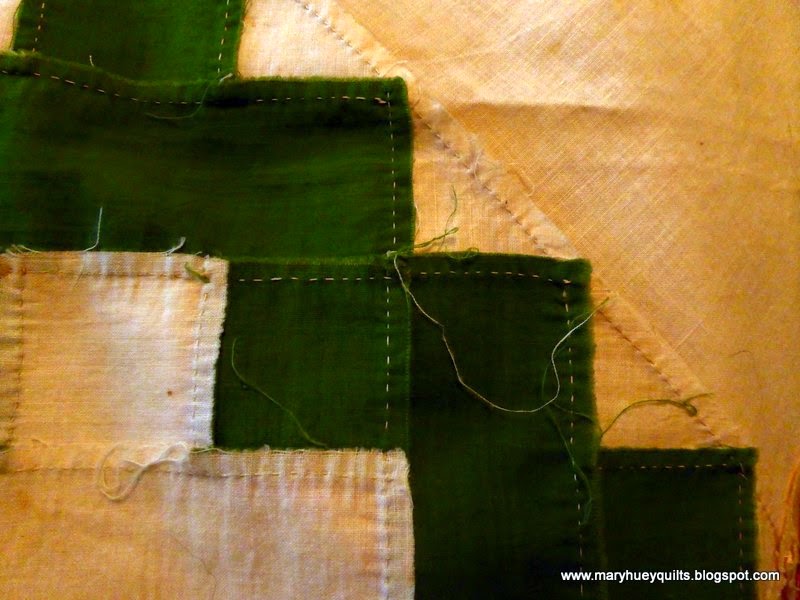In 1852, my great, great, great grandfather Jared Fox, left Wisconsin and traveled to Oregon in a wagon train to explore the possibilities of opening a new mill. It didn't work out for him and 18 months later he returned home, but he left the legacy to all of his descendants of a "overland journal".
As American History has been expanded to include the day-to-day social aspects of our culture, many journals and diaries of similar journeys have come to light. I've been interested in these since reading my copy of Jared Fox's journal over 35 years ago. The stories that can be gleaned from the writings of the women making overland journeys during the mid-1800's is very different from those of men.
I've blended together stories and excepts from those women's journals and their histories to use as a backdrop for this workshop. We are making a set of six blocks -- some quilters call it the Album block and others the Chimney Sweep. It was a popular "friendship" block during the mid-1800's and it's a easy block with minimal critical matching necessary.
Once the block is cut, it only takes about an hour to do the stitching. I used Electric Quilt to draft the block from one of my antique quilt tops. Because the pieces of the block lay on the diagonal, the measurements don't convert to any of Marti Michell's templates which is what I use most of the time.
Therefore, I used Electric Quilt to print out "rotary cutting instructions" for the block and went to work pre-cutting kits for my students -- aren't they lucky?
Obviously, the rectangles and squares needed are easily cut -- thank goodness there were no 1/8" increments on those!! One strip of a dark or medium fabric is enough to cut all the pieces needed for one 10" block.
The triangles for the sides of the blocks are cut from a large square as follows.
Cut the squares on both diagonals -- this keeps the straight of grain on the outside edges of the blocks and prevents distortion.
I'm addicted to trimming the pointy corners of these triangles off before I stitch -- they fit in place easier, the points don't get sucked into the needle hole of my sewing machine throat plate and it eliminates seam bulk which is helpful in so many ways.
That's when I pull out Marti's handy Deluxe Corner Trimmer and Hand Piecing Aid. It's an odd looking creature but we never have to cut all the way around it. Each of the six corners is a different angle.
I used the 45 degree corner which is designed to trim the points off any size right-angle triangle or 45 degree diamond (think 8-pointed star). I love having the benefits of the pre-trimmed corners even when I'm not using the templates!
A thorough instruction booklet comes with the tool that shows you how to use every aspect of it whether you are right-handed or left-handed. (Marti always includes instructions for lefties.)
Once I've cut my square on both diagonals, I slide them apart enough so that I can work around the group and trim off the points -- size isn't a factor because that tool will always match up to every corner of every 45 degree triangle.
The corners triangles were a different cut -- smaller square and only cut on one diagonal. Again this keeps the outer edges of the blocks on the straight (not-stretchy) grain.
Slid the triangles apart carefully and trim off the points. I'm working with 4 layers of fabric, so each triangle you see is actually a stack of 4 triangles.
Here are the triangles stacked up for one block -- 12 for the sides and 4 for the corners.
Here is the 120 degree corner of the tool laying on top of a hexagon -- notice the small holes drilled through the tool at regular intervals. When I'm using the
"set-in piecing simplified" technique, I can use the one right at the corner to mark my "stop" dot. When I'm hand-piecing, I can make a row of dots 1/4" from the cut edges to guide me across my stitching line.
Now I've laid it on a 60 degree diamond -- when I'm rotary cutting these diamonds without a template, I use the tool to trim off the points of the diamonds and also to mark a "stop" dot for my set-in piecing.
It's a great tool!! If you are reluctant to try to templates, this tool gives you some of the benefits and is worth trying out because it's so versatile and easy to use.
My students are from all over the United States. Every afternoon, we are gathering together to get acquainted while we stitch together our blocks and contemplate the challenges of traveling overland in a wagon train, working hard to keep a family safe and healthy.
Mary Huey



























































